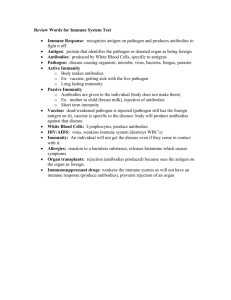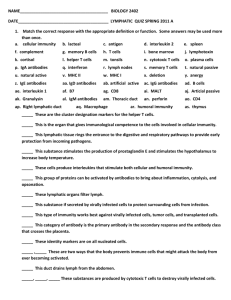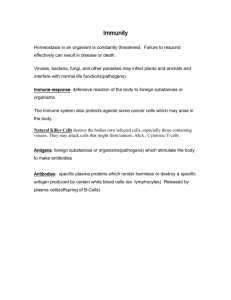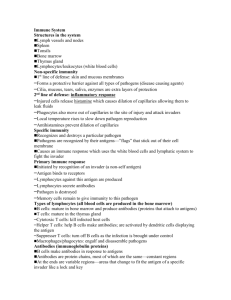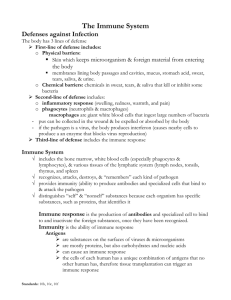AP Biology Worksheet Chapter 43 The Immune
advertisement
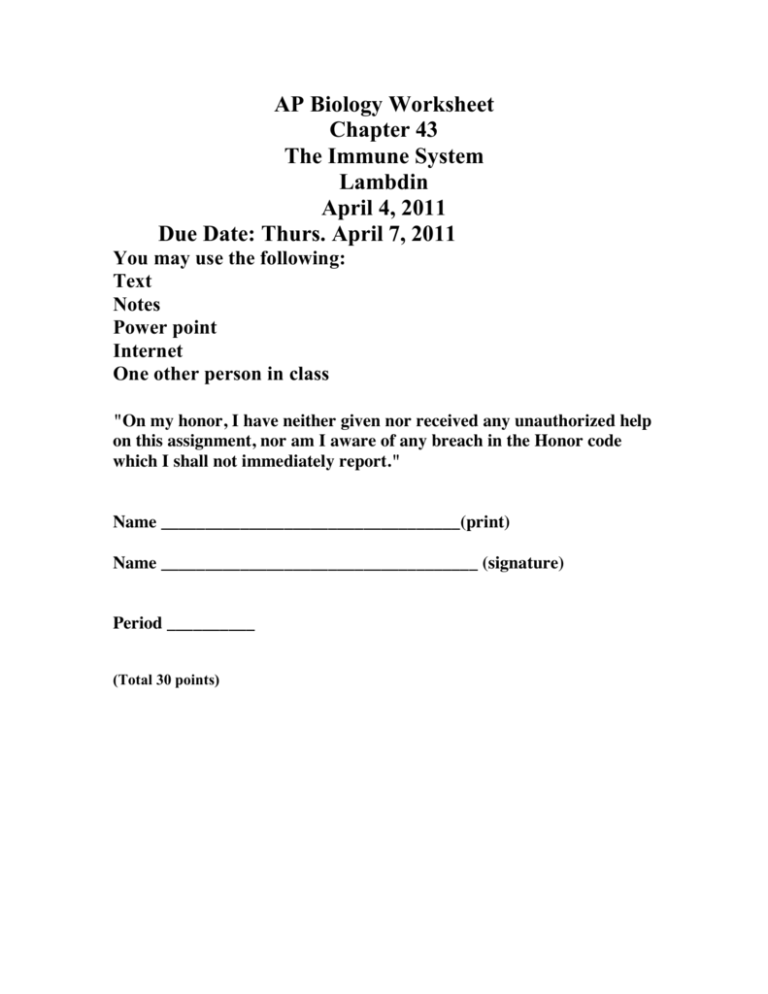
AP Biology Worksheet Chapter 43 The Immune System Lambdin April 4, 2011 Due Date: Thurs. April 7, 2011 You may use the following: Text Notes Power point Internet One other person in class "On my honor, I have neither given nor received any unauthorized help on this assignment, nor am I aware of any breach in the Honor code which I shall not immediately report." Name __________________________________(print) Name ____________________________________ (signature) Period __________ (Total 30 points) 1) Both the eye and the respiratory tract are protected against infections by which of the following? A) the mucous membranes that cover their surface B) the secretion of complement proteins C) the release of slightly acidic secretions D) the secretion of lysozyme onto their surface E) interferons produced by immune cells 2) Which cells and which signaling molecules are responsible for initiating an inflammatory response? A) phagocytes: lysozymes B) phagocytes: chemokines C) dendritic cells: interferons D) lymphocytes: interferons E) mast cells: histamines 3) Inflammatory responses may include which of the following? A) clotting proteins migrating away from the site of infection B) increased activity of phagocytes in an inflamed area C) reduced permeability of blood vessels to conserve plasma D) release of substances to decrease the blood supply to an inflamed area E) inhibiting the release of white blood cells from bone marrow 4) What are antigens? A) proteins found in the blood that cause foreign blood cells to clump B) proteins embedded in B cell membranes C) foreign molecules that trigger the generation of antibodies D) proteins that consist of two light and two heavy polypeptide chains E) proteins released during an inflammatory response 5) If a newborn were accidentally given a drug that destroyed the thymus, what would most likely happen? A) His cells would lack class I MHC molecules on their surface. B) His humoral immunity would be missing. C) Genetic rearrangement of antigen receptors would not occur. D) His T cells would not mature and differentiate appropriately. E) His B cells would be reduced in number and antibodies would not form. 6) Clonal selection is an explanation for how A) a single type of stem cell can produce both red blood cells and white blood cells. B) V, J, and C gene segments are rearranged. C) an antigen can provoke production of high levels of specific antibodies. D) HIV can disrupt the immune system. E) macrophages can recognize specific T cells and B cells. 7) Which of the following is not a component of an insect's defense against infection? A) enzyme activation of microbe-killing chemicals B) activation of natural killer cells C) phagocytosis by hemocytes D) production of antimicrobial peptides E) a protective exoskeleton Use the graph in Figure 43.1 to answer questions #8 and 9.. 8) When would B cells produce effector cells? A) between 0 and 7 days B) between 7 and 14 days C) between 28 and 35 days D) A and B E) A and C 9) When would memory cells be produced? A) between 0 and 7 days B) between 7 and 14 days C) between 28 and 35 days D) between 35 and 42 days E) both A and C 10) Which of the following differentiates T cells and B cells? A) T cells but not B cells are stimulated to increase the rate of their cell cycles. B) Only B cells are produced from stem cells of the bone marrow. C) T cells but not B cells can directly attack and destroy invading pathogens. D) T cells but not B cells have surface markers. E) Only B cells take part in cell-mediated immunity. 11) The MHC is important in a T cell's ability to A) recognize specific parasitic pathogens. B) distinguish self from nonself. C) identify specific bacterial pathogens. D) identify specific viruses. E) recognize differences among types of cancer. 12) These cells are involved in cell-mediated immunity and destroy virally infected cells: A) cytotoxic T cells B) natural killer cells C) helper T cells D) macrophages E) B cells 13) These cells are involved in cell-mediated immunity, and they respond to class I MHC molecule-antigen complexes: A) cytotoxic T cells B) natural killer cells C) helper T cells D) macrophages E) B cells 14) These cells are involved in innate immunity, and a person lacking these cells may have a higher than normal chance of developing malignant tumors: A) cytotoxic T cells B) macrophages C) helper T cells D) natural killer cells E) B cells 15) Which of the following is a pathway that would lead to the activation of cytotoxic T cells? A) B cell contact antigen → helper T cell is activated → clonal selection occurs B) body cell becomes infected with a virus → new viral proteins appear → class I MHC molecule-antigen complex displayed on cell surface C) self-tolerance of immune cells → B cells contact antigen → cytokines released D) complement is secreted → B cell contacts antigen → helper T cell activated → cytokines released E) cytotoxic T cells → class II MHC molecule-antigen complex displayed → cytokines released → cell lysis 16) Which of the following is the last line of defense against an extracellular pathogen? A) lysozyme production B) phagocytosis by neutrophils C) antibody production by plasma cells D) histamine release by basophils E) lysis by natural killer cells 17) The following events occur when a mammalian immune system first encounters a pathogen. Which shows the correct sequence in which they occur? I. Pathogen is destroyed. II. Lymphocytes secrete antibodies. III. Antigenic determinants from pathogen bind to antigen receptors on lymphocytes. IV. Lymphocytes specific to antigenic determinants from pathogen become numerous. V. Only memory cells remain. A) I → III → II → IV → V B) III → II → I → V → IV C) II → I → IV → III → V D) IV → II → III → I → V E) III → IV → II → I → V 18) Which cell type interacts with both the humoral and cell-mediated immune pathways? A) plasma cells B) helper T cells C) natural killer cells D) CD8 cells E) cytotoxic T cells 19) Which of the following are T cells of the immune system? A) CD4, CD8, and plasma cells B) cytotoxic and helper cells C) plasma, antigen-presenting, and memory cells D) lymphocytes, macrophages, and dendritic cells E) class I MHC, class II MHC, and memory cells 20) Why can normal immune responses be described as polyclonal? A) Blood contains many different antibodies to many different antigens. B) Construction of a hybridoma requires multiple types of cells. C) Multiple immunoglobulins are produced from descendants of a single B cell. D) Diverse antibodies are produced for different epitopes of a specific antigen. E) Macrophages, T cells, and B cells all are involved in normal immune response. 21) How do antibodies of the different classes IgM, IgG, IgA, IgD, and IgE differ from each other? A) in their heavy chain structure B) in the way they are produced C) in the type of cell that produces them D) by the antigenic determinants that they recognize E) by the number of carbohydrate subunits they have 22) Phagocytosis of microbes by macrophages is enhanced by which of the following? A) the binding of antibodies to the surface of microbes. B) antibody-mediated agglutination of microbes. C) the release of cytokines by activated B cells. D) A and B only E) A, B, and C 23) What is the primary function of humoral immunity? A) It primarily defends against fungi and protozoa. B) It is responsible for transplant tissue rejection. C) It produces antibodies that circulate in body fluids. D) It protects the body against cells that become cancerous. E) It primarily defends against bacteria and viruses that have already infected cells. 24) Naturally acquired passive immunity would involve the A) injection of vaccine. B) ingestion of interferon. C) placental transfer of antibodies. D) absorption of pathogens through mucous membranes. E) injection of antibodies. 25) Which of the following is true of active but not passive immunity? A) acquisition and activation of antibodies. B) proliferation of lymphocytes in bone marrow. C) transfers antibodies from the mother across the placenta. D) requires direct exposure to a living or simulated pathogen. E) requires secretion of interleukins from macrophages. 26) Jenner successfully used cowpox virus as a vaccine against the virus that causes smallpox. Why was he successful even though he used viruses of different kinds? A) The immune system responds nonspecifically to antigens. B) There are some antigenic determinants common to both pox viruses. C) The cowpox virus made antibodies in response to the presence of smallpox. D) Cowpox and smallpox are antibodies with similar immunizing properties. 27) A bone marrow transplant may not be appropriate from a given donor (Jane) to a given recipient (Jane's cousin Bob), even though Jane has previously given blood for one of Bob's needed transfusions. Which of the following might account for this? A) Jane's blood type is a match to Bob's but her MHC proteins are not. B) A blood type match is less stringent than a match required for transplant because blood is more tolerant of change. C) For each gene, there is only one blood allele but many tissue alleles. D) Jane's class II genes are not expressed in bone marrow. E) Bob's immune response has been made inadequate before he receives the transplant. 28) A transfusion of type A blood given to a person who has type O blood would result in which of the following? A) the recipient's B antigens reacting with the donated anti-B antibodies B) the recipient's anti-A antibodies clumping the donated red blood cells C) the recipient's anti-A and anti-O antibodies reacting with the donated red blood cells if the donor was a heterozygote (Ai) for blood type D) no reaction because type O is a universal donor E) no reaction because the O-type individual does not have antibodies The questions #29 and 30 refer to the following data on blood types. Figure 43.2 29) In which of the cases could the mother exhibit an anti-Rh-factor reaction to the developing fetus? A) Case 1 only B) Case 3 only C) Cases 1 and 2 only D) Cases 1, 2, and 3 E) It cannot be determined from the data given. 30) In Cases 1 and 2 in the table, the mothers would be able, if needed, to supply blood to the newborn even 7-9 months after birth; the same would not be true for Case 3. Why? A) The fetus in Case 3 would provoke an immune response in the mother that would carry over after the birth. B) This difference is based on which of the mothers has been nursing their children, not on blood antigens. C) Newborn children, until about age 2, do not make appreciable antibodies, except against Rh+ antigen. D) Passive immunity would have worn off for the third newborn, but not for the other two. E) The newborn in Case 3 would soon be able to make antibodies to the B antigen of the mother. Key 1. D 2. E 3.B 4. C 5. D 6.C 7. B 8. A 9. E 10. C 11. B 12. A 13. A 14. D 15. B 16. C 17. E 18. B 19. B 20. D 21. A 22. D 23. C 24. C 25. D 26. B 27. A 28. B 29. A 30. E

